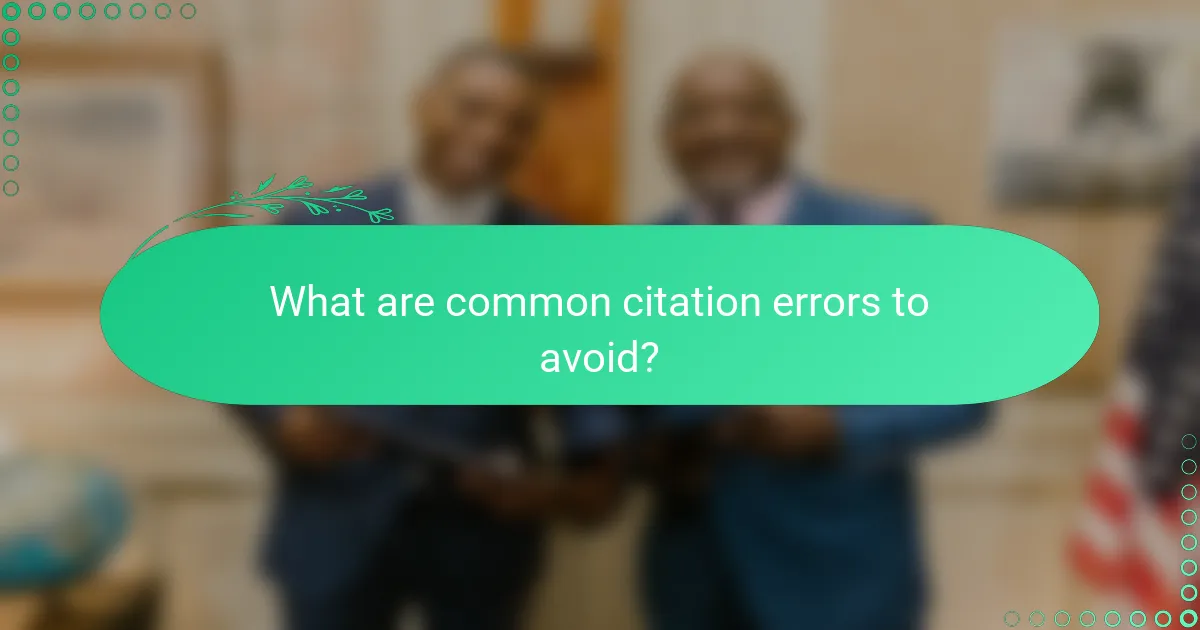Effective legal research citation techniques are crucial for maintaining clarity and accuracy in legal documents. By adhering to established citation styles and verifying information against primary sources, legal professionals can enhance their credibility and ensure consistency in their work. Understanding the specific standards that govern citations within various jurisdictions is essential for accurate referencing and effective communication in the legal field.

What are the best legal research citation techniques in the UK?
The best legal research citation techniques in the UK include using established citation styles that ensure clarity and accuracy. Familiarity with these styles helps legal professionals present their sources correctly and maintain credibility in their work.
Bluebook citation style
The Bluebook citation style is primarily used in the United States but is also recognized in some UK legal contexts. It emphasizes a uniform format for legal documents, including cases, statutes, and secondary sources.
Key components of Bluebook citations include the case name, volume number, reporter abbreviation, and page number. For example, a case citation might look like this: R v. Brown, [1994] 1 AC 212.
OSCOLA citation style
The Oxford University Standard for the Citation of Legal Authorities (OSCOLA) is the preferred citation style in the UK legal community. It is designed to provide clarity and consistency in legal writing.
OSCOLA citations typically include the case name, year, court, and relevant report series. For instance: R v. Brown [1993] 2 WLR 556. It is crucial to follow OSCOLA guidelines closely to avoid inaccuracies.
Harvard referencing style
The Harvard referencing style is widely used across various academic disciplines, including law. It focuses on author-date citations, making it easy to locate sources in the reference list.
In legal contexts, a typical Harvard citation includes the author’s surname, year of publication, title of the work, and publisher. For example: Smith, J. (2020). Legal Principles. Oxford University Press.
APA citation style
The American Psychological Association (APA) citation style is less common in legal writing but may be used in interdisciplinary contexts. It emphasizes the author’s name and publication date, similar to Harvard style.
An APA citation for a legal source might look like this: Smith, J. (2020). Understanding Law. Cambridge University Press. Ensure to adapt the format to suit legal documents when necessary.
MLA citation style
The Modern Language Association (MLA) citation style is primarily used in humanities disciplines. While not standard in legal writing, it can be applied when legal texts are analyzed in broader academic discussions.
MLA citations typically include the author’s name, title of the work, and publication details. For example: Smith, John. Law and Society. Routledge, 2021. Be cautious when using MLA for legal documents, as it may not meet legal standards.

How to ensure accuracy in legal citations?
To ensure accuracy in legal citations, it is essential to verify the information against primary sources and utilize reliable citation management tools. This practice minimizes errors and enhances the credibility of legal documents.
Cross-check with primary sources
Cross-checking with primary sources involves verifying the citation details against the original legal documents, such as court opinions, statutes, or regulations. This step is crucial as it helps confirm the authenticity and context of the cited material.
When cross-checking, pay attention to the citation format, including case names, dates, and jurisdiction. For example, ensure that the case name is spelled correctly and that the citation follows the appropriate legal format used in your jurisdiction, such as Bluebook or ALWD.
Use citation management tools
Citation management tools can streamline the process of organizing and formatting legal citations. These software applications help track sources, generate citations in various formats, and maintain consistency throughout your documents.
Popular citation management tools include Zotero, EndNote, and RefWorks. When selecting a tool, consider its compatibility with legal citation styles and its ability to integrate with word processing software. Regularly update your citation library to avoid outdated references.

What are the standards for legal citations?
Legal citations must adhere to specific standards that ensure accuracy and consistency in referencing legal documents. These standards vary by jurisdiction and institution but generally require precise formatting and the inclusion of essential information to identify the source clearly.
Jurisdiction-specific guidelines
Each jurisdiction has its own set of citation rules that legal professionals must follow. For instance, the Bluebook is commonly used in the United States, while the Canadian Guide to Uniform Legal Citation is standard in Canada. Familiarizing yourself with these guidelines is crucial to ensure that your citations meet local legal requirements.
When citing cases, statutes, or regulations, always check the specific format required by your jurisdiction. For example, U.S. federal cases typically include the name of the case, volume number, reporter abbreviation, page number, and year of decision. Adhering to these formats helps maintain the credibility of your legal research.
Institutional citation policies
Many law schools and legal institutions have their own citation policies that may differ from general jurisdictional guidelines. These policies often provide additional rules or preferences for citation formats, which can include specific abbreviations or the order of information presented.
To ensure compliance, consult your institution’s writing guide or citation manual. For example, some institutions may prefer the use of footnotes over in-text citations, or they might have specific requirements for citing online legal resources. Always double-check these policies before submitting legal documents or research papers.

How to choose the right citation format?
Choosing the right citation format is essential for ensuring clarity and consistency in legal research. Different formats serve various purposes and audiences, so understanding the context in which you are working is crucial.
Consider the audience
When selecting a citation format, consider who will be reading your document. Legal professionals, such as judges and attorneys, may expect specific formats like Bluebook or ALWD, while academic audiences might prefer APA or MLA styles. Tailoring your citation to the audience enhances credibility and comprehension.
Additionally, think about the level of formality required. For instance, court documents typically demand strict adherence to formal citation rules, while internal memos may allow for more flexibility. Always prioritize clarity and consistency to avoid confusion.
Assess the type of legal document
The type of legal document you are working with significantly influences your citation format choice. Case law, statutes, and secondary sources each have established citation styles. For example, case law often follows the Bluebook format, which includes the case name, reporter volume, and page number.
Consider the jurisdiction as well. Different jurisdictions may have unique citation requirements. For instance, federal court documents in the United States might follow the Bluebook, while state courts may have their own rules. Familiarize yourself with these distinctions to ensure accuracy in your citations.

What are common citation errors to avoid?
Common citation errors include incorrect formatting, missing information, and inconsistent citation styles. These mistakes can undermine the credibility of legal research and may lead to misunderstandings or misinterpretations of the cited material.
Incorrect formatting
Incorrect formatting refers to deviations from established citation styles, such as APA, MLA, or Bluebook. Each style has specific rules regarding punctuation, italics, and order of information, which must be followed precisely.
For example, in Bluebook format, case names should be italicized, while in APA, they should not. Failing to adhere to these formatting rules can confuse readers and detract from the professionalism of the document.
Missing information
Missing information in citations can lead to incomplete references that hinder the reader’s ability to locate the original source. Essential elements often include the author’s name, publication date, title, and source details.
For instance, a citation lacking the publication year may leave readers uncertain about the currency of the information. Always double-check that all necessary details are included to ensure clarity and accessibility.
Inconsistent citation styles
Inconsistent citation styles occur when different citation formats are used within the same document. This can confuse readers and diminish the document’s credibility, as it suggests a lack of attention to detail.
To avoid this, choose one citation style and apply it uniformly throughout the document. If multiple styles are necessary, consider providing a clear explanation or a separate bibliography that adheres to each style’s requirements.

What tools assist with legal citation?
Several tools can enhance the accuracy and efficiency of legal citation, helping researchers maintain compliance with various citation standards. These tools streamline the process of organizing, formatting, and managing citations, making it easier to produce well-cited legal documents.
RefWorks
RefWorks is a web-based reference management tool that allows users to collect, manage, and organize citations. It supports various citation styles, including APA, MLA, and Chicago, making it versatile for legal research. Users can import references directly from databases and create bibliographies with just a few clicks.
One key feature of RefWorks is its collaboration capability, allowing multiple users to work on shared projects. However, some users may find the interface less intuitive compared to other tools, so exploring its features through tutorials can be beneficial.
Zotero
Zotero is a free, open-source citation management tool that excels in collecting and organizing research materials. It integrates seamlessly with web browsers, enabling users to save citations directly from online sources. Zotero supports a wide range of citation styles, including those specific to legal writing.
A standout feature of Zotero is its ability to automatically generate citations and bibliographies in real-time. Users should be aware of the importance of regularly syncing their libraries to avoid data loss, especially when working across multiple devices.
EndNote
EndNote is a comprehensive reference management software that offers robust features for organizing citations and creating bibliographies. It is particularly favored in academic and professional settings for its extensive database compatibility and advanced search functionalities. EndNote supports numerous citation styles, including those tailored for legal documents.
While EndNote provides powerful tools for managing large volumes of references, it comes with a cost, which may be a consideration for individual users or small firms. Users should take advantage of its training resources to maximize its capabilities and avoid common pitfalls such as duplicate entries.

How does legal citation impact research credibility?
Legal citation significantly enhances research credibility by providing a clear framework for referencing sources. Accurate citations allow readers to verify information, assess the reliability of arguments, and understand the context of legal precedents.
Understanding citation standards
Citation standards in legal research, such as the Bluebook or ALWD Guide to Legal Citation, dictate how sources should be formatted and presented. These standards ensure consistency and clarity, which are essential for effective communication in the legal field.
When adhering to these citation standards, researchers should pay attention to details like case names, statutes, and page numbers. For instance, a case citation typically includes the name of the case, the volume number, the reporter, and the year of the decision.
Common citation formats
Common citation formats in legal research include case citations, statutory citations, and administrative code citations. Each format has specific rules regarding the order of information and punctuation, which must be followed to maintain accuracy.
For example, a case citation in the Bluebook format might look like this: Roe v. Wade, 410 U.S. 113 (1973). This format clearly identifies the case, the volume number, the reporter, and the year, making it easy for readers to locate the source.
Ensuring citation accuracy
Ensuring citation accuracy is crucial for maintaining the integrity of legal research. Researchers should double-check citations against authoritative sources to confirm that all details are correct. A small error in a citation can lead to misinterpretation or misapplication of the law.
To avoid common pitfalls, consider using citation management tools or software that can help organize and format citations correctly. Additionally, always keep updated with any changes in citation rules or standards that may affect your research.
